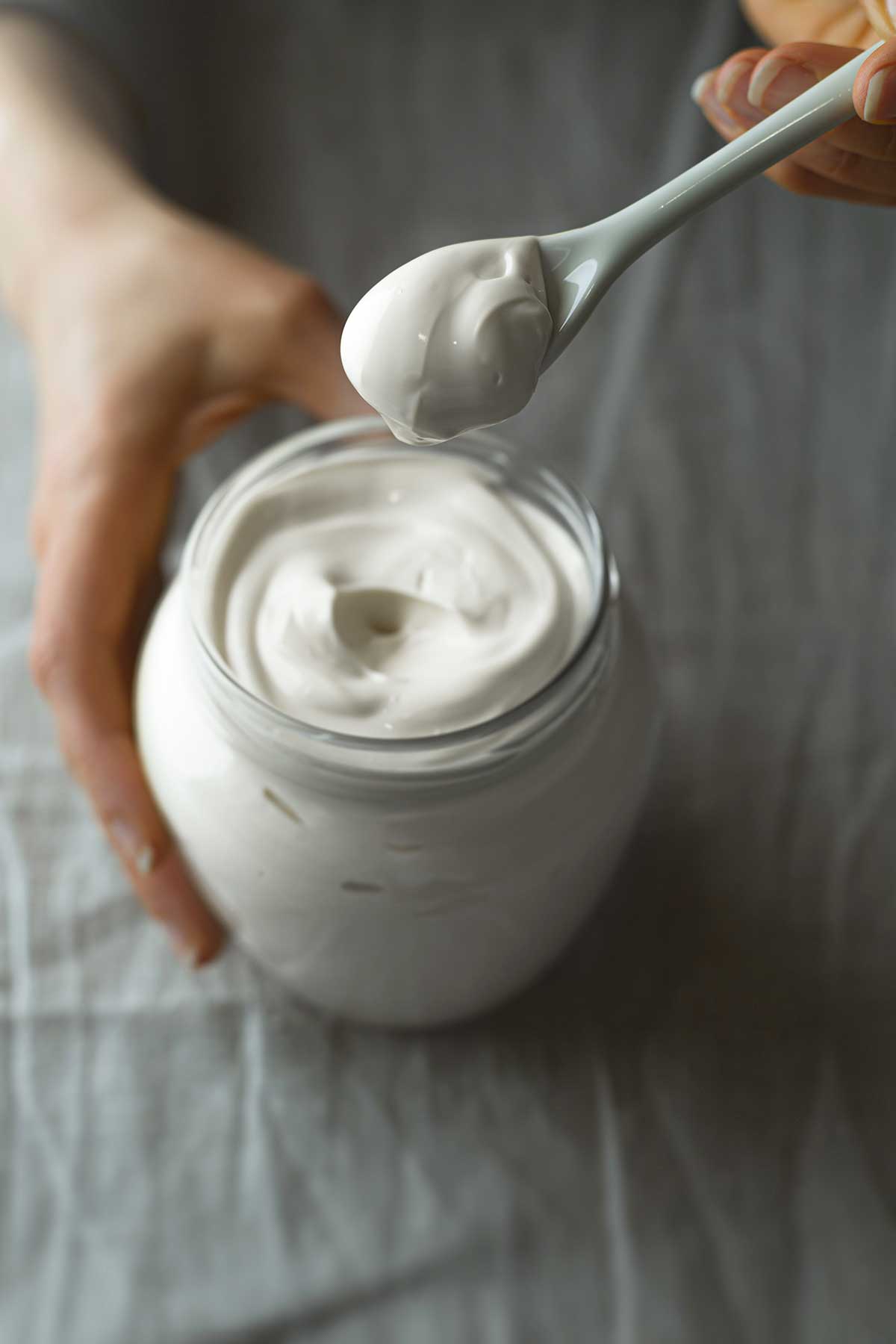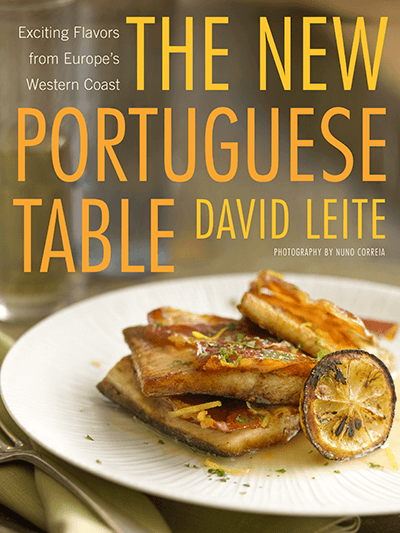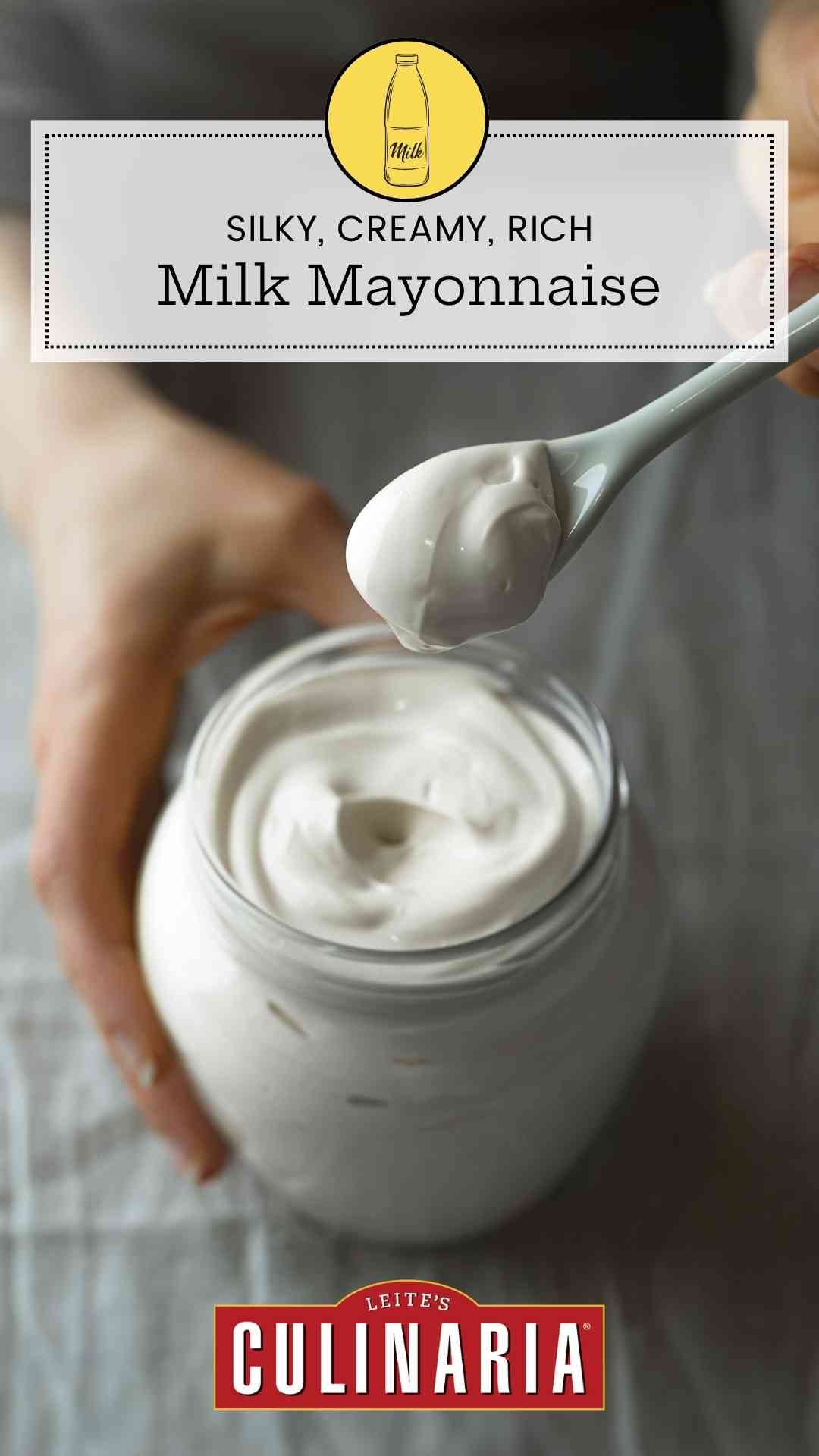
This is one of those recipes that require quotation marks, not out of affectation, but because it’s not a true mayonnaise. It contains no egg yolks or mustard. It’s nothing more than an emulsion of milk and oil. More Brazilian than Portuguese, it’s just now beginning to be used on the Continent. The taste is lighter and cleaner than that of egg-based mayonnaise, allowing other flavors to come through.
☞ Read the Article: The Secret Behind Milk Mayonnaise
Since I was given the recipe, I haven’t stopped finding ways to cook with it. The master recipe is only a canvas for additions. Besides the uses in this book, I’ve smeared the variations on grilled meats and fish, used them as dips and in dressings, spread them on sandwiches, and stirred them into potato salads, much as I do with actual mayonnaise.
Why Isn’t my Mayonnaise Emulsifying?
Like all emulsions, this recipe can be a bit finicky. But adding the oil in a thin stream and stopping when the right consistency is reached is the key. For almost foolproof results, a handheld blender is best, but a small canister blender with a narrow base will do (tall and narrow is best here). Don’t do as some of us did and assume that a stand mixer or food processor will work—it just won’t. If you’re working with a less-than-powerful immersion blender, the consistency of the mayonnaise may turn out thinner than you’d expect. You can help it along by slowly adding 2 more tablespoons of oil to the milk mayonnaise as you continue to blend and it will thicken nicely.

Milk Mayonnaise
Ingredients
- ⅓ cup very cold milk
- ¾ teaspoon fresh lemon juice
- 1 small garlic clove, peeled
- ⅛ teaspoon white pepper
- About ¾ cup vegetable oil, or 1/2 cup (118 ml) vegetable oil plus 1/4 cup (60 ml) olive oil
- Kosher salt
Instructions
- Combine the milk, lemon juice, garlic, and pepper in a 2-cup glass measuring cup. Using a handheld blender (or a blender), buzz on high for 30 seconds until frothy.
- With the motor running on high, slowly pour in the oil a few drops at a time, and gradually increase this to a fine thread, moving the blender up and down, until the mixture thickens lusciously and resembles a soft mayonnaise. You may need more or less oil.
- Season with salt to taste. The mayonnaise will last up to 1 week in the fridge.
Notes
Milk mayonnaise variations
Clockwise from top right: cilantro-ginger, curry, anchovy, sun-dried tomato.
Cilantro and Ginger Milk Mayonnaise | Maionese de Leite com Coentros e Gengibre
Add 1 loosely packed cup of well-dried fresh cilantro leaves and tendril-soft stems and a 1 1/2-inch peeled and grated thumb of ginger to the cup along with the milk, 1 3/4 teaspoons of lemon juice, and the pepper. Omit the garlic. Whir in the oil as directed above. Stir in 1 scallion cut into thin slices on the diagonal.Anchovy Milk Mayonnaise | Maionese de Leite com Anchovas
Add 6 anchovy fillets (generous 1 tablespoon) packed in oil to the cup along with the milk, lemon juice, garlic, and pepper. Whir in the oil as directed above. Omit the salt.Curry Milk Mayonnaise | Maionese de Leite com Caril
Add 2 teaspoons of your favorite curry powder to the cup along with the milk, lemon juice, garlic, and pepper. Whir in the oil as directed above. Before using, let this sit for an hour or so in the fridge to bloom.Tomato Milk Mayonnaise | Maionese de Leite com Tomate
Add 1 1/2 tablespoons of double-concentrate tomato paste to the cup along with the milk, garlic, and pepper. Omit the lemon juice. Whir in the oil as directed above. Stir in 1 tablespoon minced oil-packed sun-dried tomatoes.
Nutrition
Nutrition information is automatically calculated, so should only be used as an approximation.











Dear David,
Your recipe for milk mayonnaise is one of THE most interesting recipes ever. The first time I made it, I didn’t get it right either—my fault: I didn’t pay attention to your note, and I used the food processor (needless to say, it didn’t work). On my second trial, I used the blender and the mayonnaise emulsified like a beauty. It’s so smooth, so silky, and so aerated. So far I have only tried the green olives, but playing with other flavors is on my plan. Cheers to milk mayonnaise!
Leticia
Leticia, let us know which version you like best.
We’ve been using a soy-based mayonnaise called Vegennaise for years because of my son’s egg allergies. They sell it in two out of three of our nearby supermarkets. Because of the lecithin in soymilk, you can make soy mayo with soy milk, lemon juice and vegetable oil in a blender too.
I’d see this cow’s milk mayo as a sort of gourmet aoli alternative to the workaday soy mayo. It might also be a budget alternative seeing as it can be made in small batches with low-cost ingredients.
One recommendation I saw in recipes for soymilk mayo was to use safflower oil, because it had a neutral flavor and left you with a more traditional mayo taste. Never tested that, but now I’m tempted to do some milk mayos with different oils to see how the flavors compare.
Greg, personally I prefer the taste of the vegetable oil versus the vegetable-and-olive-oil combo. It’s actually the original recipe that Ilda gave me. It’s lighter.
I was actually contemplating a vegetable/peanut oil mix, maybe with some anchovy paste and parmesan as a veggie dip, and one with some sesame oil, fivespice, and ginger as an aïoli for a roasted pork sandwich.
Both sound great. Take a look at the green olive dip, as it uses anchovies, too.
The curry and tomato versions are lovely for veggie dipping (especially hot steamed artichokes), but it’s the green olive dip I keep coming back to. I could eat that dip with a spoon! It’s definitely stable in my fridge for at least two weeks—no separating or weeping and we’ve all survived. I find it tends to get eaten before there’s a chance of it spoiling.
Where’s the green olive recipe?
Hello, Luci. You can find it here.